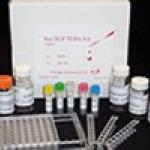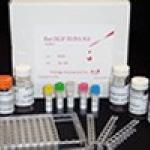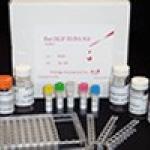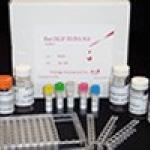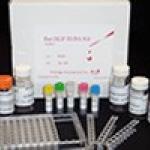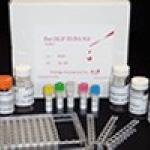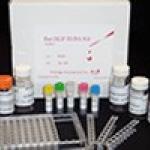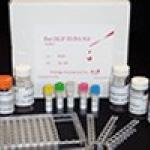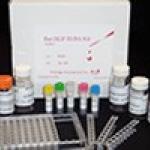-
Specification:96TestDescription:
Platelet-derived growth factors (PDGFs) constitute a group of growth factors that play a significant role in blood vessel formation (angiogenesis), and the growth of blood vessels from already existing blood vessel tissue. There are five different isoforms of PDGF, including PDGF-A, PDGF-B, PDGF-C, PDGF-D and an AB…
-
Specification:96TestDescription:
Platelet-derived growth factors (PDGFs) constitute a group of growth factors that play a significant role in blood vessel formation (angiogenesis), and the growth of blood vessels from already existing blood vessel tissue. There are five different isoforms of PDGF, including PDGF-A, PDGF-B, PDGF-C, PDGF-D and an AB…
-
Specification:96TestDescription:
Platelet-derived growth factors (PDGFs) constitute a group of growth factors that play a significant role in blood vessel formation (angiogenesis), and the growth of blood vessels from already existing blood vessel tissue. There are five different isoforms of PDGF, including PDGF-A, PDGF-B, PDGF-C, PDGF-D and an AB…
-
Specification:96TestDescription:
Pigment epithelium-derived factor (PEDF) is a multipotent neurotrophic factor with potent activity both in the central nervous system and in the retina. To date, PEDF is the most potent angiogenic inhibitor found in the mammalian ocular compartment. Interestingly, recent studies have shown that decreased ocular…
-
Specification:96TestDescription:
Pemphigus is a rare group of blistering autoimmune diseases that affect the skin and mucous membranes.
In pemphigus, autoantibodies form against desmoglein. Desmoglein forms the "glue" that attaches adjacent epidermal cells via attachment points called desmosomes. When autoantibodies attack desmogleins, the cells…
-
Specification:96TestDescription:
Platelet Factor (PF4) is a 70 amino acid, 30,000 D molecular ratio protein. PF4 is released from activated platelet α granules in a tetrameric form complexed with platelet proteoglycan. Upon release, the half-life of PF4 is very short, less than 5 minutes, as it quickly binds to endothelial cell glycosaminoglycans…
-
Specification:96TestDescription:
Prostaglandin D2 (PGD2) is biosynthesized in the brain by a lipocalin-type PGD2 synthase where it acts in the CNS to promote sleep induction and lowering of body temperature.PGD2 is also the major eicosanoid product of mast cells and is synthesized in large quantities by a hematopoetic-type PGD synthase during…
-
Specification:96TestDescription:
This assay was developed for screening applications in which the relative amount of prostaglandin (PG) production for a large number of cell culture samples must be determined. Our PGE2 assay (Catalog No. 514010) is unparalleled in sensitivity and specificity, but the steep standard curve can make screening many…
-
Specification:96TestDescription:
Prostaglandin E1 (PGE1) is pharmaceutically known as Alprostadil. It is used as a drug in the treatment of erectile dysfunction and has vasodilatory properties.Alprostadil is sold in the United States as urethral suppositories, under the brand name MUSE (Medicated Urethral Suppository for Erection) by Vivus. It is…
-
Specification:96TestDescription:
Prostaglandin E2 (PGE2) is a primary product of arachidonic acid metabolism in many cells. Like most eicosanoids, it does not exist preformed in any cellular reservoir. When cells are activated or exogenous free arachidonate is supplied, PGE2 is synthesized de novo and released into the extracellular space. In vivo…
 Specification:96TestDescription: Platelet-derived growth factors (PDGFs) constitute a group of growth factors that play a significant role in blood vessel formation (angiogenesis), and the growth of blood vessels from already existing blood vessel tissue. There are five different isoforms of PDGF, including PDGF-A, PDGF-B, PDGF-C, PDGF-D and an AB…
Specification:96TestDescription: Platelet-derived growth factors (PDGFs) constitute a group of growth factors that play a significant role in blood vessel formation (angiogenesis), and the growth of blood vessels from already existing blood vessel tissue. There are five different isoforms of PDGF, including PDGF-A, PDGF-B, PDGF-C, PDGF-D and an AB… Specification:96TestDescription: Platelet-derived growth factors (PDGFs) constitute a group of growth factors that play a significant role in blood vessel formation (angiogenesis), and the growth of blood vessels from already existing blood vessel tissue. There are five different isoforms of PDGF, including PDGF-A, PDGF-B, PDGF-C, PDGF-D and an AB…
Specification:96TestDescription: Platelet-derived growth factors (PDGFs) constitute a group of growth factors that play a significant role in blood vessel formation (angiogenesis), and the growth of blood vessels from already existing blood vessel tissue. There are five different isoforms of PDGF, including PDGF-A, PDGF-B, PDGF-C, PDGF-D and an AB… Specification:96TestDescription: Platelet-derived growth factors (PDGFs) constitute a group of growth factors that play a significant role in blood vessel formation (angiogenesis), and the growth of blood vessels from already existing blood vessel tissue. There are five different isoforms of PDGF, including PDGF-A, PDGF-B, PDGF-C, PDGF-D and an AB…
Specification:96TestDescription: Platelet-derived growth factors (PDGFs) constitute a group of growth factors that play a significant role in blood vessel formation (angiogenesis), and the growth of blood vessels from already existing blood vessel tissue. There are five different isoforms of PDGF, including PDGF-A, PDGF-B, PDGF-C, PDGF-D and an AB… Specification:96TestDescription: Pigment epithelium-derived factor (PEDF) is a multipotent neurotrophic factor with potent activity both in the central nervous system and in the retina. To date, PEDF is the most potent angiogenic inhibitor found in the mammalian ocular compartment. Interestingly, recent studies have shown that decreased ocular…
Specification:96TestDescription: Pigment epithelium-derived factor (PEDF) is a multipotent neurotrophic factor with potent activity both in the central nervous system and in the retina. To date, PEDF is the most potent angiogenic inhibitor found in the mammalian ocular compartment. Interestingly, recent studies have shown that decreased ocular… Specification:96TestDescription: Pemphigus is a rare group of blistering autoimmune diseases that affect the skin and mucous membranes. In pemphigus, autoantibodies form against desmoglein. Desmoglein forms the "glue" that attaches adjacent epidermal cells via attachment points called desmosomes. When autoantibodies attack desmogleins, the cells…
Specification:96TestDescription: Pemphigus is a rare group of blistering autoimmune diseases that affect the skin and mucous membranes. In pemphigus, autoantibodies form against desmoglein. Desmoglein forms the "glue" that attaches adjacent epidermal cells via attachment points called desmosomes. When autoantibodies attack desmogleins, the cells… Specification:96TestDescription: Platelet Factor (PF4) is a 70 amino acid, 30,000 D molecular ratio protein. PF4 is released from activated platelet α granules in a tetrameric form complexed with platelet proteoglycan. Upon release, the half-life of PF4 is very short, less than 5 minutes, as it quickly binds to endothelial cell glycosaminoglycans…
Specification:96TestDescription: Platelet Factor (PF4) is a 70 amino acid, 30,000 D molecular ratio protein. PF4 is released from activated platelet α granules in a tetrameric form complexed with platelet proteoglycan. Upon release, the half-life of PF4 is very short, less than 5 minutes, as it quickly binds to endothelial cell glycosaminoglycans… Specification:96TestDescription: Prostaglandin D2 (PGD2) is biosynthesized in the brain by a lipocalin-type PGD2 synthase where it acts in the CNS to promote sleep induction and lowering of body temperature.PGD2 is also the major eicosanoid product of mast cells and is synthesized in large quantities by a hematopoetic-type PGD synthase during…
Specification:96TestDescription: Prostaglandin D2 (PGD2) is biosynthesized in the brain by a lipocalin-type PGD2 synthase where it acts in the CNS to promote sleep induction and lowering of body temperature.PGD2 is also the major eicosanoid product of mast cells and is synthesized in large quantities by a hematopoetic-type PGD synthase during… Specification:96TestDescription: This assay was developed for screening applications in which the relative amount of prostaglandin (PG) production for a large number of cell culture samples must be determined. Our PGE2 assay (Catalog No. 514010) is unparalleled in sensitivity and specificity, but the steep standard curve can make screening many…
Specification:96TestDescription: This assay was developed for screening applications in which the relative amount of prostaglandin (PG) production for a large number of cell culture samples must be determined. Our PGE2 assay (Catalog No. 514010) is unparalleled in sensitivity and specificity, but the steep standard curve can make screening many… Specification:96TestDescription: Prostaglandin E1 (PGE1) is pharmaceutically known as Alprostadil. It is used as a drug in the treatment of erectile dysfunction and has vasodilatory properties.Alprostadil is sold in the United States as urethral suppositories, under the brand name MUSE (Medicated Urethral Suppository for Erection) by Vivus. It is…
Specification:96TestDescription: Prostaglandin E1 (PGE1) is pharmaceutically known as Alprostadil. It is used as a drug in the treatment of erectile dysfunction and has vasodilatory properties.Alprostadil is sold in the United States as urethral suppositories, under the brand name MUSE (Medicated Urethral Suppository for Erection) by Vivus. It is… Specification:96TestDescription: Prostaglandin E2 (PGE2) is a primary product of arachidonic acid metabolism in many cells. Like most eicosanoids, it does not exist preformed in any cellular reservoir. When cells are activated or exogenous free arachidonate is supplied, PGE2 is synthesized de novo and released into the extracellular space. In vivo…
Specification:96TestDescription: Prostaglandin E2 (PGE2) is a primary product of arachidonic acid metabolism in many cells. Like most eicosanoids, it does not exist preformed in any cellular reservoir. When cells are activated or exogenous free arachidonate is supplied, PGE2 is synthesized de novo and released into the extracellular space. In vivo…

